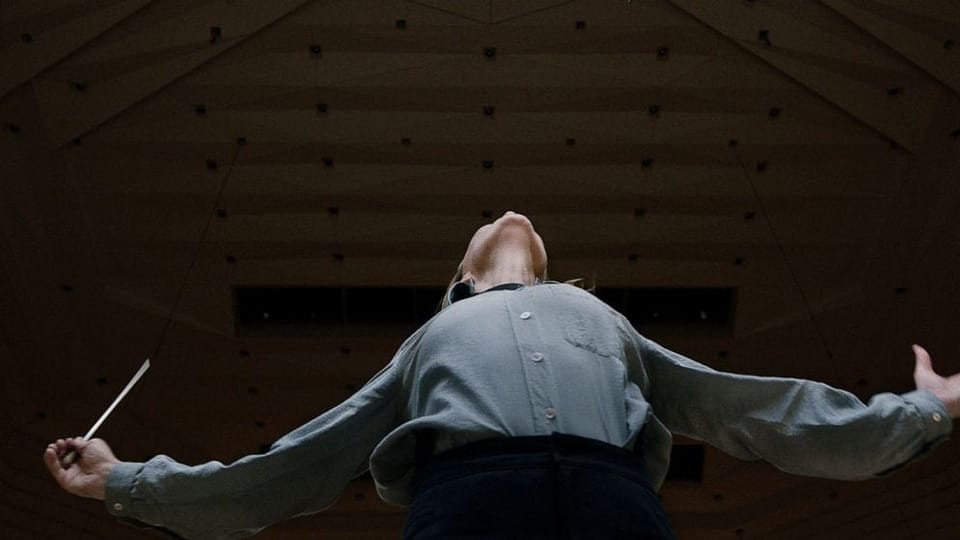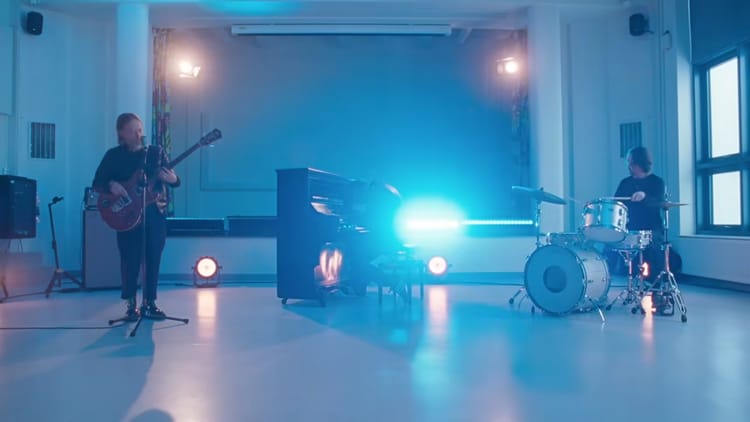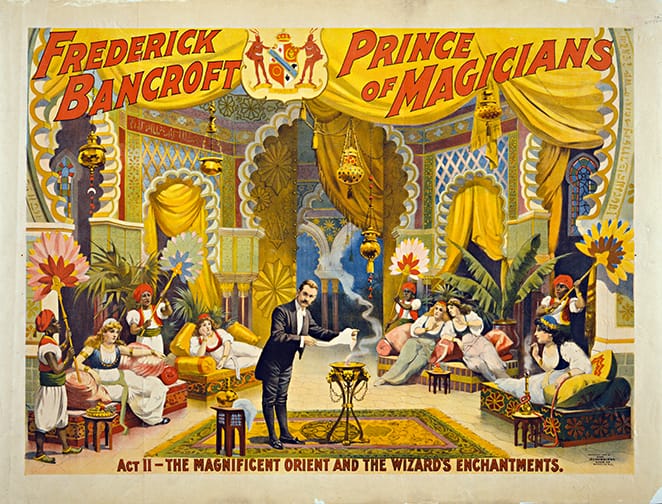"Tár" Reviewed

Review: Tár
“We can’t always name the things we feel,” Leonard Bernstein declares late in Tár, writer/director Todd Field’s return to the screen after an absence of 16 years. “Every once in a while, we have feelings so deep and so special that we have no words for them. And that's where music is so marvelous: because music names them for us.”
Bernstein appears courtesy of a videotaped broadcast of the 1958 CBS program What Does Music Mean? Viewing this tape is Lydia Tár (Cate Blanchett), a woman who constantly speaks her feelings even as the things she feels most deeply remain so beyond the grasp of her conscious perception that she becomes a buzzing, and increasingly fragmentary, hive of cognitive dissonance.
Lydia is, we learn in the opening scene (in which she is introduced prior to an onstage discussion hosted by the New Yorker) the world’s preeminent orchestral conductor. If there can be such a thing as a celebrity conductor, Lydia is it—and, we learn, she could probably best be described as a genius, her composing work having earned her coveted EGOT status. At the outset, Lydia is installed at the Berlin Philharmonic, where she will be presenting her long-anticipated interpretation of Mahler’s fifth symphony. She’s barely had time to begin preparing, though, when a cascade of compounding pressures begin settling upon her shoulders. Lydia is happy to be abrasive, and she refuses to be shackled by needless social graces or fashionable standards of sensitivity, and as she moves through her world, she lays the tracks for her creeping self-destruction even as previously laid tracks bring the consequences of past actions to her door.
The easiest, and hackiest, way to describe Tár would be to say that it’s “about cancellation.” This descriptor might suggest some satirical take on recent history, complete with shorthand, winks and nods. There have been any number of cancellation movies and TV series in the past few years, and they tend to be hollow in their provocations and tin-eared in their sanctimony.
But Tár is not about cancellation. Tár is about Tár. Field has built an immensely textured and immersive world for the story of an immensely specific and complex character. There is not a single stock figure or scenario in Tár; it’s a breathtakingly original story taking place in a world so detailed it feels like we could step directly into it, and all the while, under our noses, Field sews detonators into the story’s seams, all of them timed precisely for maximum, if often muted, dramatic impact.
In addition to being about Tár, Tár is about conducting, and the thematic resonance Field draws from Lydia’s occupation is fascinating. The film makes a seemingly undeniable case for conducting as a valid form of artistry—in one scene, she sits at a piano demonstrating just how profoundly interpretation can influence the sound of a piece of music. Lydia treats orchestral scores as clay, and she would be just as happy to treat the world around her in the same manner—as we will eventually learn, she’s done something like that with her own existence. Her manipulations of her circumstances and associates, executed as casually as a drawn breath, testify to the profundity of her desire to direct life with ferocious control.

The moment in which Lydia demonstrates her theories of interpretation comes around the midpoint of an exceptionally long scene taking place in a university classroom. The scene begins with a student conductor presenting his work to the class, and it concludes some time later with that student storming out with a new grudge against Lydia Tár. The journey from entry point to exit is a long one, and it follows in a chain of very long scenes, Field treating us to entire voluminous conversations and encounters where other directors would provide only the most salient snippet. There could be a version of Tár that’s half as long without losing any plot. Rather than suggesting bloat, though, I only mean to say this is a film that flows like the tide, drawing the viewer into Lydia’s repressed psyche so gradually they won’t feel the undertow until it’s too late.
Tár begins with its own closing credits, which play backwards in successive still cards containing blocks of names–we begin with the dedication, move on to the acknowledgements, and then cruise in reverse through the scores of technicians and craftspeople that bring a film to fruition. The sequence is scored by an eerie, wailing vocalist, and the effect feels quite literally hypnotic–by the time of Blanchett’s delayed entrance onto the scene, I felt my breath having deepened, my posture relaxed. Like a deep-sea diver entering some new pressurized space, I found myself submerged in this movie, happy to roam the depths of Field’s vision for as long as he’d have me.
It might be hard to say precisely what position Tár takes on that vaguest of modern-day boogeymen, cancel culture. I’d be tempted to say the film’s observing eye is essentially agnostic, more fascinated by the social phenomena that coalesce into a personal quagmire for someone whose most innate behaviors—probably inextricable from the qualities that make them a genius—put them on a collision course with their own undoing. Tár is a film devoid of not just convenient answers but, seemingly, any answers at all; it revels in life ambiguities, a theme underscored by the persistently eerie phenomena (an unseen screamer here, a too-hostile neighbor there) that erupt around Lydia like spasms from her own unsettled unconscious.
Tár is a haunted film, and a tense one, creating the impression that something outrageous could flare at any time (and make no mistake, it does). But this is not an insistent cinematic paranoia; rather, the itchy experience of watching the film is all a credit to its patience, and how by simply leaving us in scenarios longer than we expect, we find our expectations for cinematic narrative upended.
To focus on Tár’s tension, though, is to obscure the fact that it also happens to be hilarious, making space for slapstick, sight gags (including a final shot that caused me to briefly transcend time and space), a new hit novelty song about urban real estate, and heaping doses of cringing comedy of manners. Watching Tár, it’s not hard to feel that you’re experiencing every shade on life’s color wheel at once.
I have struggled to write this review—I knew walking out of Tár that I was enraptured, but the words to express why have eluded me over the past week. At least there are the scenes of Lydia conducting; as dense as they may be with character shading and thematic weight, those scenes are also, in the most classical version of the word, awesome. And in the true closing credits—which, having cleared away every other name in the beginning, now marvels at every composer and performer whose work contributed to this opus—it’s clear that the music is what’s offered to name this film’s uncanny mass of feeling.
Tár opens today, October 7, in New York and LA. It goes wide the following week, October 14.
Sundry Ephemera
I’ll be spending the rest of 2022 revisiting movies relevant to my book on the cinematic Bob Dylan, so last week I took in what must be my fifth or sixth viewing of the Coen brothers’ Inside Llewyn Davis. The film is basically about Bob Dylan without being about Bob Dylan—once you know the whole story is leading up to Dylan sharing the bill with Llewyn on a wintry Greenwich Village night, a wink and nod from the Coens telling us that guys like Llewyn are about to be bulldozed by the future, it becomes easier to see the breadcrumbs left earlier on. There’s a flash of Bob in the opening scene that you don’t know to look for until repeat viewings, while a significant reference to “the Times” coming to that night’s show (a likely reference to Ron Shelton’s starmaking 1961 review of Dylan) indicates that this might, in fact, be one very special night in history.

My relationship with Inside Llewyn Davis has been anything but linear; I found myself profoundly nonplussed by my first watch, and since then it’s been a process of first making sense of what the film is and then plumbing its depths, from its Sisyphean structure and existentialist ennui to its deep immersion in the fragmentary world of the “neo-ethnic” folk revivalists of the early 1960s. On this watch, I was most struck by the reverence the movie has for the music being performed. I don’t think the Coens cut away from a single song in the entire movie. Instead, well over half a dozen times in this 105-minute film, we hold still to enjoy this beautiful music made by a bunch of deluded, hostile, desperately idealistic people whose entire way of life is heading straight for the chopping block. There aren’t many movies that feel like Inside Llewyn Davis, and I’d venture to say that’s a big reason why.
Meanwhile, I’ve been lazily making my way through the Friday the 13th movies for the first time—last year, I spent late September and early October doing the same with the Halloween franchise, and as I finished well before the 31st, I thought I might keep the party rolling with Jason’s exploits, but two slasher franchises in one autumn proved too much, and I put the book of Camp Crystal Lake back on the shelf to wait another 12 months. But now it’s finally time, and so across the past few weeks I’ve taken down Friday the 13th Part 2, Friday the 13th Part III (yes, I know it’s a digit in one title and a Roman numeral in the other; yes this stresses me out too) and the erroneously titled Friday the 13th: The Final Chapter. To be blunt, I’m not sure this is my franchise—I miss the gonzo Spy vs Spy antics between Halloween’s Michael Myers and Dr. Loomis, which really means I miss any sense of continuity to these things. The Friday the 13th movies seem designed to be as disposable as possible, with the characters existing only to stop existing.

I do like the fact, though, that the franchises offer two distinct flavors of campfire story. I like the constant urge towards mythmaking in the Halloween franchise, whether that means inflating Laurie’s significance to Michael or whatever those “evil runes” had to do with everything by the mid-90s. But with that niche filled, I don’t mind that the series’ closest kin is something this consistently mean and totally free of pretension. Forced to differentiate between them, I guess I’d put Part 2 at the head of the pack, as it really feels like the platonic ideal of a certain collective unconscious understanding of “the teen slasher movie.” Part III seemingly has nothing much to recommend it save for some fabulously ostentatious blocking intended to highlight what I’m sure was some stunning 3-D technology. And The Final Chapter features Crispin Glover as an anxious nerd and Corey Feldman as a little creep who turns into a REAL little creep, so there’s plenty to like, and I’ll admit the ending to that one has actually managed to stay under my skin a few days later. I’ll keep strolling through, I’m excited to see how wacky things will get by the time Jason is in New York, not to mention space. But I’ll confess, I’m not exactly scrambling for the remote every night.
Oh yeah, also…
It was pretty silly of you to read me on Tár when you could have been reading Fran on Tár.
There’s a Spotify playlist featuring 25 songs my bosom friend Ryan Pollie has produced. You should listen to them, because they’re all good, because Ryan is good at his job.
For the new B-movies issue of Bright Wall/Dark Room, I covered one of my favorite inexplicable movies, Monte Hellman’s existentialist Western The Shooting.
I reviewed Mike Flanagan’s new YA show The Midnight Club for Polygon. I think it’s kind of a mess, but it’s also extremely not made for me!




